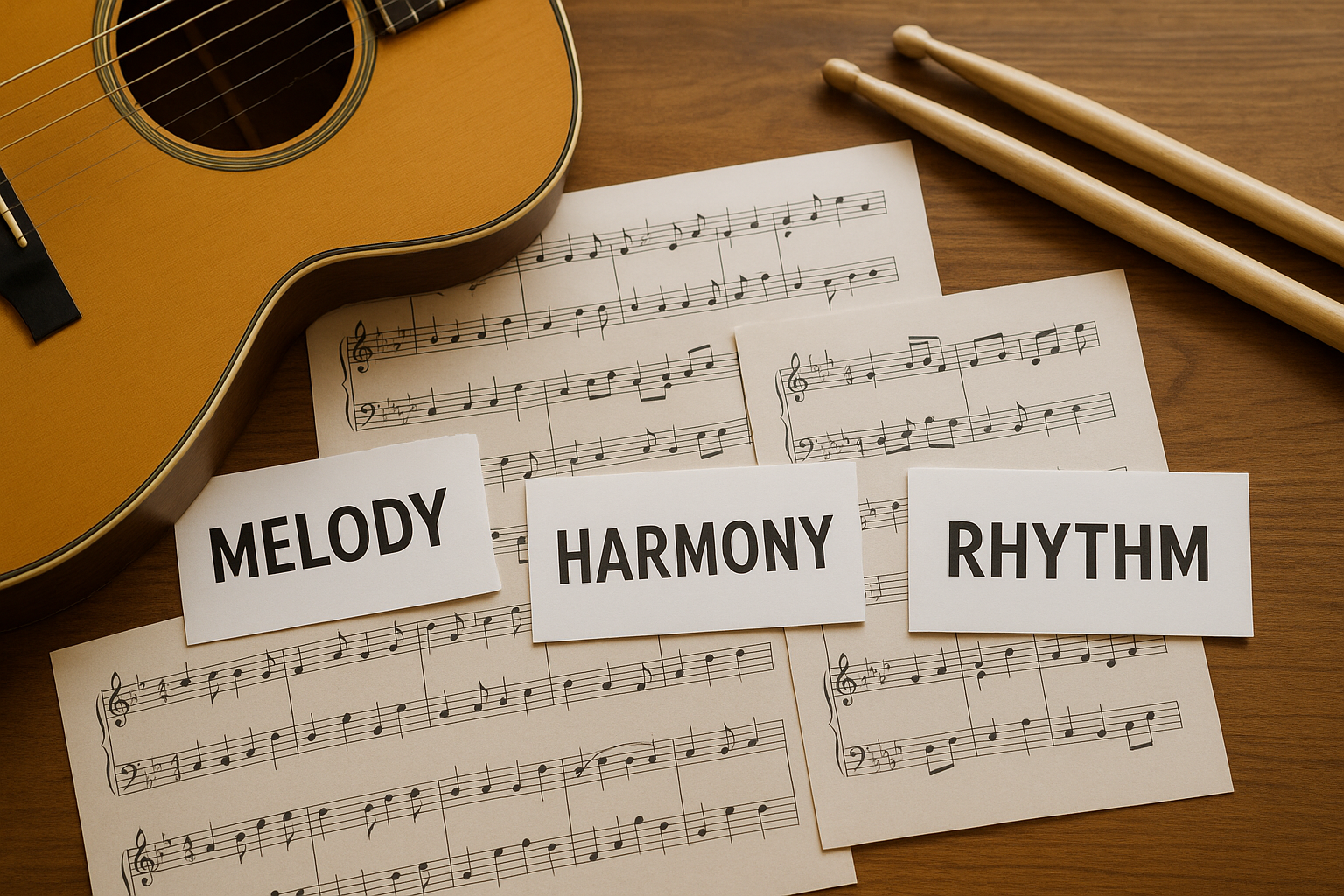If you’re just starting to learn music, you’ve likely come across the terms melody, harmony, and rhythm. These three elements form the foundation of virtually every musical piece, regardless of genre or style. But what do they actually mean, and how do they work together?
Let’s break them down in a simple, beginner-friendly way so you can better understand what you’re hearing—and playing.
What Is Melody?
Melody is the most recognizable part of a song. It’s the series of notes that you could hum, sing, or whistle. When someone says, “I can’t get this tune out of my head,” they’re talking about the melody.
A melody is made up of individual pitches (notes) played in a sequence, usually one at a time. It has shape, contour, and emotion. It’s the musical line you follow and remember.
Example:
Think of the song Happy Birthday. The part you sing is the melody.
Melody characteristics:
- Linear (notes played one after the other)
- Can be sung or played on a single instrument
- Often the “main voice” of a piece
- Can be simple or complex
Instruments like the voice, violin, or flute often carry the melody because they’re capable of producing clear, singable lines.
What Is Harmony?
Harmony is what happens when two or more notes are played at the same time. It adds depth and richness to the music. While the melody stands out in front, harmony is like the background color that enhances the picture.
Harmony supports the melody by creating chords—combinations of notes that sound pleasing (or intentionally dissonant). You might not always notice the harmony right away, but you’d definitely feel if it were missing.
Example:
When a group sings in different voice parts (like soprano, alto, tenor, and bass), they’re creating harmony. In a band, the guitarist or keyboardist often provides harmony using chords.
Harmony characteristics:
- Vertical (notes played at the same time)
- Creates chords and chord progressions
- Enhances the emotional tone of the melody
- Can be simple (one chord) or complex (modulations, jazz voicings)
What Is Rhythm?
Rhythm is the timing of the notes and sounds. It controls when notes are played and for how long. Even if you played just one note over and over, changing the rhythm would create a completely different musical feel.
Rhythm includes beats, tempo (speed), time signature, and note durations (quarter notes, eighth notes, etc.). It is the engine that drives the music forward.
Example:
Clapping your hands in a steady beat is rhythm. So is tapping your foot to the beat of a song—even if no melody is playing.
Rhythm characteristics:
- Related to time, not pitch
- Includes beat, tempo, meter, and syncopation
- Present in percussion-heavy music (like drums) but exists in all music
- Essential for groove, feel, and structure
Even melody and harmony rely on rhythm to tell them when to happen. Without rhythm, music would just be a bunch of random sounds.
How These Elements Work Together
Let’s say you’re listening to your favorite song:
- The part you hum is the melody.
- The rich background chords from the piano or guitar are the harmony.
- The drums and bass that keep the song moving are providing the rhythm.
These three work together to create complete, engaging music. If you remove one, the music feels flat or incomplete.
A Simple Analogy
Think of music like a cake:
- Melody is the flavor—what you taste first.
- Harmony is the frosting and layers—what gives it depth.
- Rhythm is the structure—the recipe and baking time that holds everything together.
All parts are necessary for a delicious result.
Why It’s Important to Understand the Difference
As a beginner, understanding these elements will help you:
- Analyze songs more effectively
- Communicate better with other musicians
- Improve your practice, focusing on one element at a time
- Compose and improvise with more confidence
- Understand sheet music and theory with clarity
If you’re learning an instrument, this knowledge can transform how you approach your practice. Instead of just playing notes, you’ll start thinking about what role each part plays in the music.
Tips for Practicing Each Element
Here’s how you can work on melody, harmony, and rhythm individually:
Melody Practice:
- Try singing melodies from memory
- Play simple melodies by ear
- Learn famous tunes on your instrument
Harmony Practice:
- Study basic chords on your instrument
- Listen to how chords change in your favorite songs
- Use simple sheet music to identify harmonies
Rhythm Practice:
- Clap or tap along to different songs
- Practice with a metronome
- Learn different time signatures (4/4, 3/4, etc.)
You can also record yourself and listen back to notice how these elements sound in your playing.
Final Thoughts: Build a Strong Musical Foundation
Understanding the difference between melody, harmony, and rhythm is like learning the ABCs of music. With this foundation, everything else becomes easier—whether you’re learning your first instrument, reading sheet music, or writing your own songs.
As you progress, you’ll notice how these elements intertwine and support each other. Great music isn’t just about playing the right notes—it’s about knowing how to bring those notes to life through melody, harmony, and rhythm.
